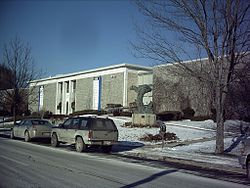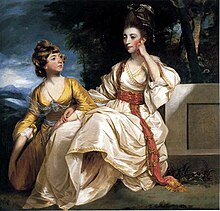User:HazelAB/Beaverbrook Art Gallery
 Beaverbrook Art Gallery on 14 December, 2005. | |
 | |
| Established | 1959 |
|---|---|
| Location | 703 Queen St Fredericton New Brunswick E3B 1C4 |
| Coordinates | 45°57′35″N 66°38′08″E / 45.9598°N 66.6356°E |
| Type | Art museum |
| Visitors | 25,000 annually (2012) |
| Director | Terry Graff |
| Website | www.beaverbrookartgallery.org |
The Beaverbrook Art Gallery is a public art gallery in Fredericton, New Brunswick, Canada. It is named after Max Aitken, Lord Beaverbrook, who funded the building of the gallery. Beaverbrook had spent his childhood and youth in New Brunswick and after he became a wealthy press baron in England he made many gifts to the province. The Beaverbrook Art Gallery, completed when its founder was 80 years old, was to be the last of these gifts. The Beaverbrook Art Gallery is New Brunswick's officially designated provincial art gallery.
The Building
[edit]In 1954 Lord Beaverbrook made an offer to Hugh John Flemming, the Premier of New Brunswick, to build and stock an art gallery in Fredericton. [1]: 71 The Province accepted the proposal, and provided him with a site directly across from the New Brunswick Legislative Building on the southern bank of the Saint John River. Neil Stewart, of the Fredericton architectural firm Howell & Stewart, designed the mid-century modern building.[2] The flat-roofed single-storey building is faced with pale semi-glazed brick. It has a granite base, with cornices and a frieze of white marble quarried at Philipsburg, Quebec. The original exhibition space consisted of one high-ceilinged central gallery with a square gallery on either side. [3]
In 1983 the building was expanded with the addition of east and west wings. These additions, funded by Marguerite Vaughan and the Beaverbrook Canadian Foundation respectively, housed the Hosmer Pillow Vaughan collection of china and other decorative arts, and the Sir Max Aitken Gallery. In 1995 another expansion housing the Marion McCain Atlantic Gallery was opened. Its name honours the late wife of New Brunswick businessman Harrison McCain, who contributed $1,000,000 to fund the project.[1]: 193
The Collection
[edit]Lord Beaverbrook's collection
[edit]
The gallery opened with a collection of more than 300 paintings, mostly British, that had been assembled by Lord Beaverbrook.[4] Most of the works had been purchased by Beaverbrook himself, with the assistance of advisors including Sir Alec Martin, managing director of Christie's, W.G. Constable, curator of the Boston Museum of Fine Arts, and Lady Dunn, the widow of the industrialist and art collector Sir James Dunn. Lady Dunn became Lady Beaverbrook when the two were married in 1963, a year before his death.
According to contemporary news reports the total value of the collection was $2,100,000.[5] It included works by J. M. W. Turner, John Constable, Thomas Gainsborough, Joshua Reynolds, Edwin Henry Landseer and other 18th and 19th century British artists. Beaverbrook had also acquired works by contemporary artists with whom he was personally acquainted, including Augustus John, William Orpen, and Graham Sutherland. Acting on the advice of Le Roux Smith Le Roux, he bought several paintings from the 1955 Daily Express Young Artists Exhibition, which Le Roux had organized. These included Lucian Freud's Hotel Bedroom, which won second prize in the exhibition.[1]: 73
In 1954, Lord Beaverbrook had set up the Beaverbrook U.K. Foundation, a charitable foundation one of whose objects was "the purchasing for or providing funds for the purchase by libraries museums or art galleries in the Province [of New Brunswick]... of books manuscripts papers letters periodicals maps paintings prints statuary and other documents or works of art..."[1] : 68 Beaverbrook gave the paintings he had already acquired to the Beaverbrook U.K. Foundation, and subsequent purchases of works for the Gallery were made by the Foundation.
In addition to Lord Beaverbrook's own acquisitions, the Gallery had received two major donations of artworks before its opening. Toronto businessman James Boylen donated 22 paintings by Cornelius Krieghoff. Lady Dunn donated three portraits by Walter Sickert and three works by Salvador Dali. Two of the Dali paintings were portraits of Lord and Lady Dunn, while the third was the very large painting Santiago El Grande, which was on display in the central gallery when the Beaverbrook Art Gallery opened and has become closely identified with the Gallery. This painting, which measures thirteen by ten feet, and represents Spain's patron saint James the Great on a white horse, had been created for the Spanish Pavilion at the 1958 Brussels World's Fair.[1] : 90–91
The Permanent collection
[edit]In 2012 there were 3600 items in the gallery's permanent collection, which is made up of four separate collection areas: The British Collection, The Canadian Collection, the International Collection, and the New Brunswick Collection.[6] The core of the The British Collection is the original Beaverbrook collection with which the gallery opened. In the Canadian Collection, the gallery hosts an extensive collection of 19th- and 20th-century Canadian artists such as the Group of Seven, Emily Carr, David Milne and Jean-Paul Riopelle. Within the Canadian Collection there is an emphasis on work from the Atlantic region, and the gallery has extensive holdings of work by Christopher Pratt, Bruno Bobak, and Jack Humphrey. among others. The International Collection contains representative works from the fourteenth to the twentieth centuries. The Hosmer Pillow Vaughan Collection of Continental fine and decorative art forms part of the International Collection. In 1994 The Beaverbrook Art Gallery was designated the provincial art gallery of New Brunswick. A separate New Brunswick Collection was established to ensure a comprehensive historical survey of New Brunswick art, including work by Acadian, Maliseet, and Mi'kmaq artists. [7] [8]
The TD Sculpture Garden
[edit]In 2009 a sculpture garden was inaugurated adjacent to the Gallery. The first sculpture to be commissioned was The Birth of Venus by New Brunswick Acadian artist André Lapointe.[9] In 2012 the Gallery received a $300,000 donation from TD Bank Group to support the initiative, which was named the TD Sculpture Garden.[10]
Sculptures by Jonathan Kenworthy (The Leopard) and Marie-Hélène Allain (Awakening/Éveil) have been on display on the lawns in front of the Gallery since 1985.[11]
Ownership disputes
[edit]A dispute arose in 2003 between the Gallery and the Beaverbrook U.K. Foundation over custody of the paintings Lord Beaverbrook had purchased for the collection. This was followed by a second dispute between the Gallery and the Beaverbrook Canadian Foundation over paintings that had been donated to the Gallery by Lady Beaverbrook (formerly Lady Dunn). The foundations proposed to take back and sell some of the most valuable works in the collection to raise funds for their charitable activities. The Beaverbrook Art Gallery maintained that it had received permanent custody of the works, citing the wishes of Lord Beaverbrook himself at the time of the gallery's creation.

The Beaverbrook U.K. Foundation
[edit]Since the Beaverbrook Art Gallery's opening, the Beaverbrook U.K. Foundation had paid the insurance premiums on 133 paintings that Lord Beaverbrook had donated through the Foundation. In 2002 the Foundation hired Sotheby's to obtain a current valuation of the insured works, which the Gallery's director had valued at $7.6 million in Canadian funds in 2000. Sotheby's found that the collection had a value of ₤35 million, nearly $90 million in Canadian funds. Turner's 1834 painting The Fountain of Indolence alone was estimated to be worth between $16.7 million and $25 million, and Freud's Hotel Bedroom between $5.2 million and $8.4 million in Canadian funds.[1] : 203
This large increase in value would entail a corresponding rise in the cost to the Foundation of insuring the works, and would in turn reduce the amount the Foundation could devote to its charitable causes in England. In 2003 the Foundation, which was headed by Lord Beaverbrook's grandson Maxwell Aitken, proposed to take back and sell the two most valuable paintings, The Fountain of Indolence and Hotel Bedroom. It would use the proceeds to pay the considerably reduced insurance premiums on the remaining works and to fund its causes in England. The Foundation would give the Gallery $5 million for its endowment fund, and guarantee that the remaining works would stay in the Gallery for at least the following ten years. [1] : 206–207 This would have required the Gallery's Board of Directors to acknowledge that the paintings belonged to the Foundation, which they refused to do. In July 2004 the two parties submitted the case to arbitration under the New Brunswick Arbitration Act, agreeing that the case should be heard by retired Supreme Court of Canada justice Peter Cory.
The dispute proceeded to arbitration, and a ruling was handed down on March 26, 2007. Of the 133 disputed paintings, 85 were ruled as being gifts from the original Lord Beaverbrook, while 48 paintings were to be returned to the custody of the Beaverbrook U.K. Foundation. Justice Cory also ruled that the Foundation should pay $4.8 million in costs.The Foundation appealed the decision and a panel of three retired Canadian judges heard the appeal. On 9 September 2009 the panel confirmed the the original ruling dividing the paintings between the two parties. The Fountain of Indolence and Hotel Bedroom were among the works that stayed in the possession of the Gallery. [12]

The Beaverbrook Canadian Foundation
[edit]The second dispute involves the Beaverbrook Canadian Foundation's claim to ownership of 78 works that had been donated by Lady Dunn (later Lady Beaverbrook) personally or by the Dunn Foundation. After Lord Beaverbrook's death in 1964, his widow denied that the paintings belonged to the Gallery and proposed to withdraw them from the collection. In 1970 the Beaverbrook Canadian Foundation, then chaired by Sir Max Aitken, arranged to purchase the paintings from her for a total of $250,000. This was done at the request of Wallace Bird, the Chair of the Gallery's Board of Directors and Lieutenant-Governor of the province, in order to keep them in the custody of the Gallery.[1]: 154–157 The dispute between the Gallery and the Canadian Foundation is unresolved.[13]
References
[edit]- ^ a b c d e f g h Poitras, Jacques (2007). Beaverbrook: A Shattered legacy. Fredericton, NB: Goose Lane Editions. ISBN 9780864925220.
- ^ Leroux, John (2008). Building New Brunswick: An Architectural history. Fredericton, NB: Goose Lane Editions. p. 197. ISBN 9780864925046.
- ^ Carr, Angela (23 October 2011). "Architecture of Art Galleries in Canada: Beaverbrook Art Gallery". The Canadian Encyclopedia. Historica Canada. Retrieved 10 February 2014.
- ^ "Masterworks from the Beaverbrook Art Gallery". Beaverbrook Art Gallery. Retrieved 10 February 2014.
- ^ "Beaver's greatest landmark". Time. 74 (13): 64. 28 September 1959. ISSN 0040-781X.
- ^ Beaverbrook Art Gallery (September 2012). "New Brunswick Cultural Policy Renewal" (PDF). Retrieved 10 February 2014.
- ^ "Beaverbrook Art Gallery". The Canadian Encyclopedia. Historica Canada. 5 October 2006. Retrieved 10 February 2014.
- ^ "About the permanent collection". Beaverbrook Art Gallery. Retrieved 10 February 2014.
- ^ "Beaverbrook Art Gallery held opening reception for New Sculpture Garden and Art Bank exhibition". Beaverbrook Art Gallery. 7 December 2009. Retrieved 12 February 2014.
- ^ "Beaverbrook Campaign". Beaverbrook Art Gallery. Retrieved 12 February 2014.
- ^ Fredericton Heritage and Cultural Affairs. A Guide to public art in Fredericton.
- ^ "Fredericton gallery wins appeal over Beaverbrook collection". CBC News New Brunswick. 9 September 2009. Retrieved 11 February 2014.
- ^ "Max Aitken hopes to end latest Beaverbrook art dispute". CBC News New Brunswick. 28 September 2012. Retrieved 12 February 2014.
External links
[edit]- Arbitration Act, SNB 1992, c A-10.1
- Beaverbrook Art Gallery website
- Beaverbrook Art Gallery Act, RSNB 2011, c119
- Beaverbrook Art Gallery at Canada's Historic Places
45°57′35″N 66°38′08″W / 45.9598°N 66.6356°W
[
